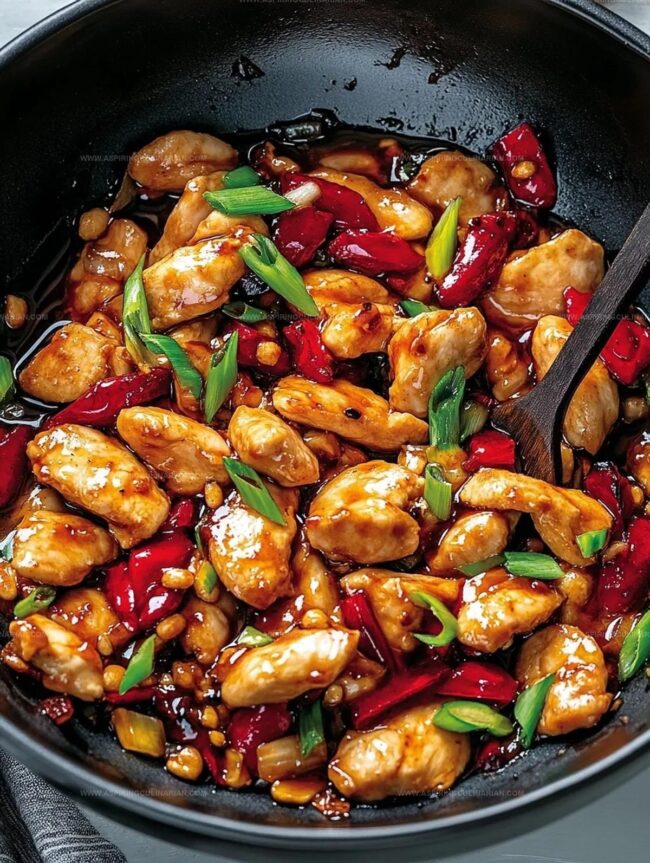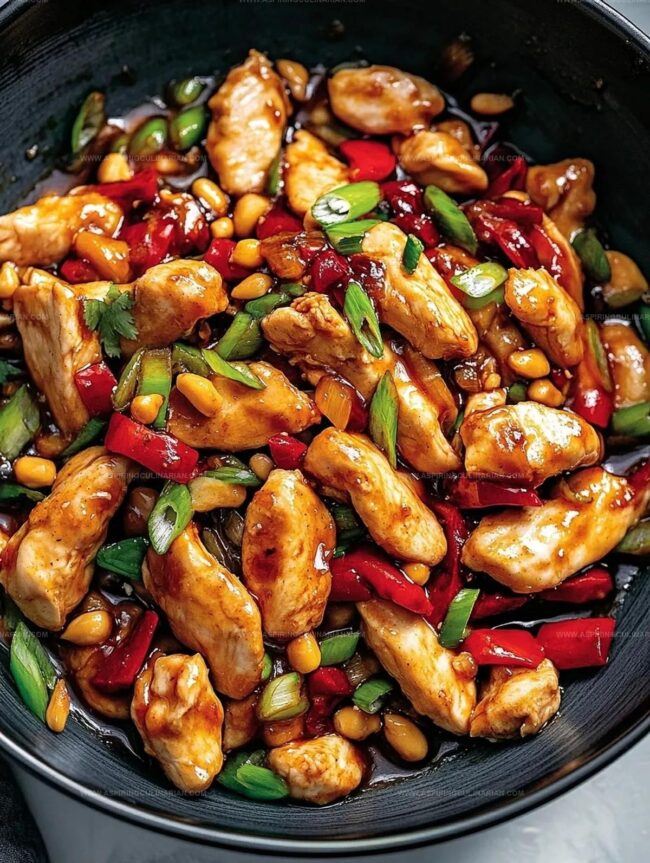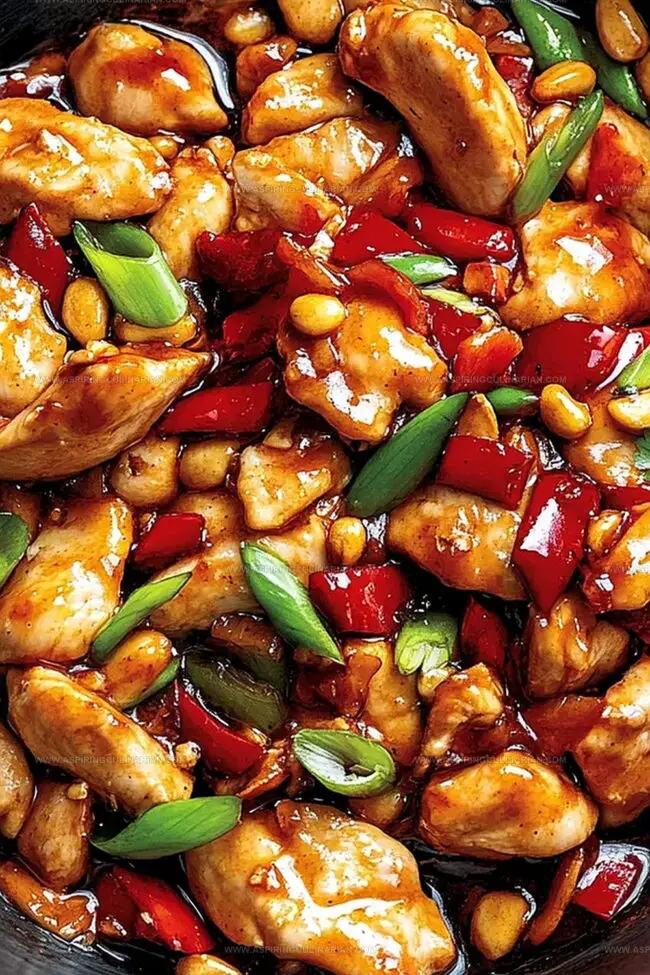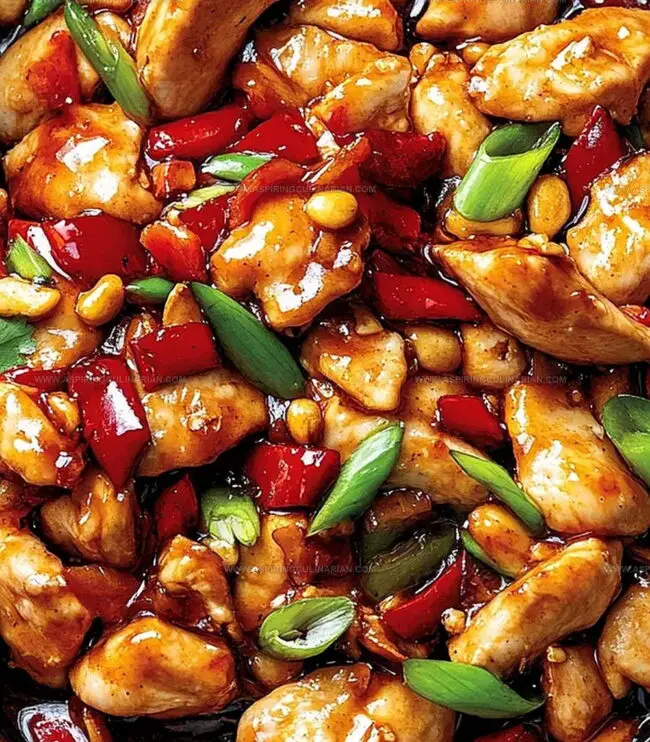Quick Homemade Kung Pao Chicken Recipe: Zippy & Soul-Warming
Spice up your weeknight dinner with this authentic kung pao chicken recipe that brings the bold flavors of Sichuan cuisine right to your kitchen.
The homemade kung pao chicken delivers a perfect balance of heat, tang, and savory goodness that will make your taste buds dance.
Tender chicken pieces sizzle with crunchy peanuts and vibrant vegetables, creating a symphony of textures and tastes.
Forget takeout – this recipe offers a fresher, more personalized approach to a classic Chinese dish.
Each bite packs a delightful punch of chili, garlic, and umami that will transport you to the bustling streets of Chengdu.
The secret lies in carefully selected ingredients and a simple cooking technique that anyone can master.
Dive into this mouthwatering adventure and impress everyone at your dinner table with a restaurant-quality meal made entirely from scratch.
Homemade Kung Pao Chicken Flavor Highlights
Ingredients for Homemade Kung Pao Chicken Success
Main Protein:Sauce Ingredients:Cooking and Flavor Enhancers:Preparing Homemade Kung Pao Chicken Like a Pro
Step 1: Whip Up the Zesty Sauce
Create a flavor explosion by mixing soy sauce, rice vinegar, hoisin sauce, and cornstarch in a mixing bowl.
Whisk the ingredients until they blend into a smooth, glossy mixture that will make your taste buds dance.
Step 2: Sizzle the Chicken
Fire up a skillet with vegetable oil over medium heat.
Toss in the chicken pieces and let them sear until they turn a gorgeous golden brown, developing a crispy exterior that locks in all the juicy goodness.
Step 3: Toss in Colorful Companions
Introduce bell peppers and crunchy peanuts to the sizzling pan.
Stir-fry these vibrant ingredients until the peppers soften and become slightly tender, releasing their sweet, fresh flavors.
Step 4: Drench in Delicious Sauce
Pour the previously prepared sauce over the chicken and vegetables.
Let everything simmer and bubble, allowing the sauce to thicken and lovingly coat each morsel with its rich, tangy essence.
Step 5: Sprinkle and Serve
Shower the dish with freshly sliced green onions and a sprinkle of fiery red pepper flakes.
Plate alongside steaming rice and get ready to enjoy a homemade Kung Pao Chicken that rivals any restaurant version.
Kung Pao Chicken Tips for Extra Flavor
Kung Pao Chicken Unique Style Ideas
How to Serve Homemade Kung Pao Chicken Best
Storing Homemade Kung Pao Chicken Properly
FAQs
The key ingredients are chicken, bell peppers, peanuts, soy sauce, rice vinegar, hoisin sauce, and cornstarch. These components create the classic flavor profile of this popular Chinese-American dish.
Yes, it typically has a moderate level of heat from red pepper flakes. You can adjust the spiciness by adding more or less red pepper flakes according to your taste preference.
Absolutely! You can substitute chicken with tofu, shrimp, or beef while keeping the same sauce and cooking method. Each protein will bring a unique twist to the classic recipe.
Print
Homemade Kung Pao Chicken Recipe
- Total Time: 18 minutes
- Yield: 4 1x
Description
Spicy Kung Pao Chicken brings sizzling Sichuan flavors straight from China’s culinary heart. Tender chicken, crisp peanuts, and fiery chili peppers dance together, promising a delicious journey through authentic regional cuisine you won’t forget.
Ingredients
Protein:
- 1 pound (454 grams) chicken breast, sliced
Vegetables and Nuts:
- 1 bell pepper, sliced
- 2 green onions, sliced
- 1/2 cup (75 grams) roasted peanuts
Sauce and Seasonings:
- 1/4 cup (60 milliliters) soy sauce
- 2 tablespoons (30 milliliters) rice vinegar
- 1 tablespoon (15 milliliters) hoisin sauce
- 1 tablespoon (8 grams) cornstarch
- 1 tablespoon (15 milliliters) vegetable oil
- 1 teaspoon (2 grams) crushed red pepper flakes
Instructions
- Whisk soy sauce, rice vinegar, hoisin sauce, and cornstarch in a mixing bowl until the mixture becomes smooth and fully integrated.
- Warm vegetable oil in a large skillet over medium-high heat, around 375°F. Carefully add chicken pieces and sauté for 4-5 minutes, ensuring each piece develops a golden-brown exterior.
- Introduce diced bell peppers and roasted peanuts into the skillet, continuously stirring to prevent burning and promote even cooking for approximately 2-3 minutes.
- Gradually pour the prepared sauce over the chicken and vegetable mixture, allowing it to simmer and thicken for 1-2 minutes until it creates a glossy, uniform coating.
- Remove the skillet from heat and transfer the kung pao chicken to a serving platter, generously garnishing with thinly sliced green onions and a sprinkle of red pepper flakes for an extra kick of flavor.
- Serve immediately alongside steamed jasmine rice, ensuring the dish remains hot and maintains its vibrant texture and temperature.
Notes
- Customize heat levels by adjusting red pepper flakes, perfect for those who prefer mild or spicy dishes.
- Select chicken thighs for extra juiciness and richer flavor compared to chicken breast.
- Use unsalted roasted peanuts to control overall sodium content and enhance nutty undertones.
- Prep ingredients beforehand to ensure quick and smooth stir-frying, preventing burning or overcooking.
- Prep Time: 10 minutes
- Cook Time: 8 minutes
- Category: Dinner, Lunch, Appetizer
- Method: Sautéing
- Cuisine: Chinese
Nutrition
- Serving Size: 4
- Calories: 400
- Sugar: 5 g
- Sodium: 800 mg
- Fat: 16 g
- Saturated Fat: 2 g
- Unsaturated Fat: 14 g
- Trans Fat: 0 g
- Carbohydrates: 30 g
- Fiber: 3 g
- Protein: 35 g
- Cholesterol: 75 mg






Lena Martinez
Contributing Writer & Culinary Educator
Expertise
Southwestern and Latin American cuisines, Vegetarian and plant-based recipe development, Culinary education and community outreach
Education
Santa Fe Community College, Santa Fe, NM
Certificate in Culinary Arts
Emphasized Southwestern cuisine and sustainable cooking practices
Lena grew up surrounded by the colors, spices, and traditions of the Southwest – flavors that sparked her love for bold, honest cooking. After earning her Culinary Arts certificate at Santa Fe Community College, she made it her mission to teach home cooks how to create flavorful, plant-powered meals without the fuss.
Her recipes are packed with vibrant ingredients, simple steps, and the kind of heart that turns a regular meal into something you’ll want to share. Outside the kitchen, Lena spends her time wandering farmers’ markets, trading family recipes, and helping young chefs find their voice through food.